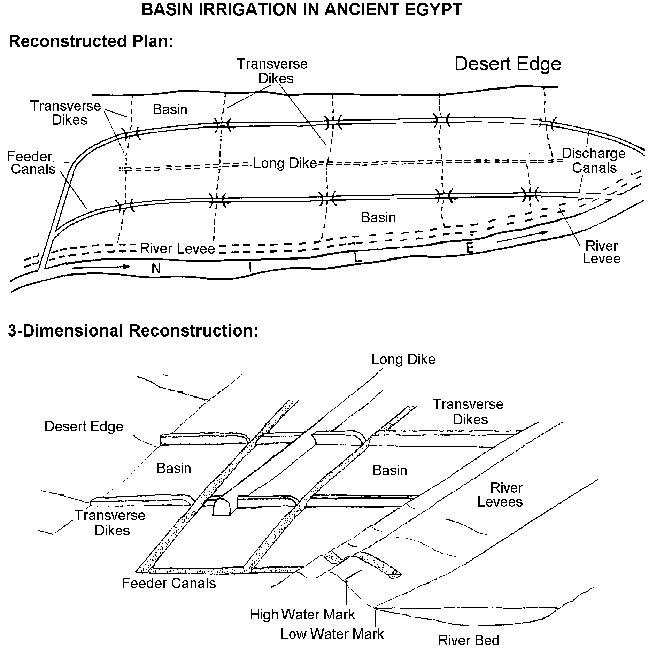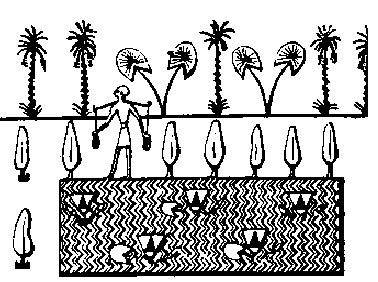| The Ancient Use of Hydroponics | |||||
|
|
Aquaculture
and Hydroponics -
Hyroglyphs or picturegraphs from ancient Egypt show gardens that were enclosed in walls behind Egyptian homes. The gardens included several ponds, and the water stored in the ponds was used to water garden plants. The ponds were also used to raise fish, and the garden owner would fish in his own garden. The ponds were also used to grow lotus flowers that were a part of the Egyptian diet. The water used for the garden was fertilized by the fish, so this form of agriculture is a very ancient example of aquaculture water being used to raise food. Plots to raise vegetables were laid out in small grids, and each grid cell was enclosed with a small ledge to keep water in the grid area. Whole gardens included fruit trees and vineyards. A portion of the garden was used to grow an ancient wheat, similar to our present day Kamut. Egyptian gardens were used to supply a major portion of the daily supply of fresh food. The garden was also used to grow large amounts of flowers, beehives and sometimes support animals and pets. Egyptian gardens probably used sand and soil in their gardens for media. There were several walls made of stone, and the garden ponds were often lined in stone. Water was hand carried to the plants in the garden, perhaps because pumps were not yet invented and labor was very cheap. But Egyptian social life partially depended upon a quiet garden seting. The Egyptians would sit by their garden ponds and fish for the captive fish in the pond. It appears that both nets and fishing rods were used. The fish grown in the ponds may have included Nile Tilapia, and the Nile Perch. The waters from the ponds would have to be kept clean by including fresh water, or by filtering. Garden plots were laid out in a tub-like system, and water was supplied from the pond. An Egyptian fishes for pond raised fish in his garden. Fish supply fertilizer for the garden plants. Water carrier takes water from garden pond to plants in the garden. Notice the lotus blossoms in the pond. The fish in the water ponds produce wastes that are then used in the garden as fertilizer. A schematic plan of an Egyptian garden shows four ponds (dark black) feeding a garden of trees, vines and other plants. The waters from the ponds were used for the gardens and fertilized the garden with fish wastes. By this simple system the early use of aquaculture waters used for hydroponics was established. ![[A Pond with carrying bags]](page_image/egyptgarden.gif)
The gardens were carefully laid out and considered part of the living space of a home. Because Egypt is so close to the Equator the winter season is very warm, and no greenhouse space would be needed. However there were ways to increase shade including high walls. The Egyptians also used a unique form of irrigation.

The Egyptians used the Nile Tilapia in their garden ponds, and perhaps other fish. The Nile Tilapia is a herbacious fish that can thrive is waters that are or poor quality. They grow to about 1.5 pounds in about four months and are an excellent flavored fish if the waters they occupy are pure. The tilapia can keep their own area clean
of excess vegetation, and eat lotus roots, and duckweed. The wastes from
a tilapia will build up in an isolated pond and they will soon die. If
the water is used for a hydroponic culture and returned to the pond, the
hydroponic can clean the water of fish wastes.1 |
|
|||
|
|
|||||
|
|
|||||
|
|
|||||
|
|
|||||
|
|
|||||
|
|
|||||
|
|
|||||
|
1Bradley Hydroponics, 1998. |
|||||

![[King fishing in his garden pond]](page_image/king.gif)